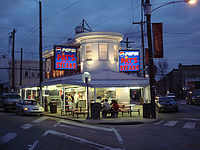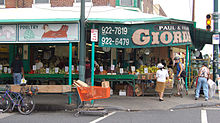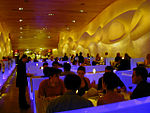- Cuisine of Philadelphia
-
The cuisine of Philadelphia was shaped largely by the city's mixture of ethnicities, available foodstuffs and history. Certain foods have become iconic to the city. Invented in Philadelphia in the 1930s, the cheesesteak is the most well known icon of the city, and soft pretzels have become a part of Philadelphia culture. During the 18th century city taverns were major meeting places for politicians and businessmen, while the 19th century saw the creation of two Philadelphia landmarks, the Reading Terminal Market and Italian Market. After a dismal restaurant scene during the post-war era of the 20th century, the 1970s brought a restaurant renaissance that has continued into the 21st century.
Contents
Innovations and icons
Philadelphia's large immigrant population has contributed to a large mixture of tastes to mingle and develop. Many types of foods have been created in or near Philadelphia or have strong associations with the city. In the 1900's Philadelphia's most iconic foods were established as the cheesesteak, Hoagie, soft pretzel, Water Ice and Soda pop.
The cheesesteak is a sandwich traditionally made with sliced beef and melted cheese on an Italian roll. In the 1930s, the phenomenon as a steak sandwich began when hot dog vendor brothers Pat Olivieri and Harry Olivieri put grilled beef on a hot dog bun and gave it to a taxi driver.[dubious ] Later, after Pat and Harry had started selling the sandwich on Italian rolls, the cheesesteak was affixed in the local culture when one of their cooks put melted cheese on the sandwich. Originally, the cheese was melted in a separate container to accommodate their large clientele who followed kosher rules (thereby not mixing dairy and meat). Today, cheese choices in Philadelphia eateries are virtually limited to American, Provolone, or Cheese Whiz. The latter is especially popular in those places that prominently carry it.
The hoagie is another sandwich that is said to have been invented in Philadelphia, undoubtedly of origin in Italian-American cuisine. It has been asserted that Italians working at the World War I era shipyard in Philadelphia, known as Hog Island where emergency shipping was produced for the war effort, introduced the sandwich, by putting various sliced meats, cheeses, and lettuce between two slices of Italian bread. This became known as the "Hog Island" sandwich; hence, the "hoagie".[1] Declared the official sandwich of Philadelphia in 1992, the hoagie is a sandwich made of meat and cheese with lettuce, tomatoes, and onions on an Italian roll.[2] Another Italian roll sandwich is the roast pork Italian. The sandwich consists of sliced roast pork with broccoli rabe or spinach and provolone cheese.[3] Philadelphia Pepper Pot, a soup of tripe, meat, vegetables, is claimed to have been created during the American Revolutionary War and named after the home city of its creator.[4] Snapper Soup, a thick brown turtle soup served with sherry, is a Philadelphia delicacy, generally found in area bars and seafood restaurants. In many places, it is served with oyster crackers (such as OTC Crackers, OTC being an abbreviation for "Original Trenton Cracker") and horseradish.
The snack item commonly associated with Philadelphia, but not invented there, is the soft pretzel. The soft pretzel dates back to 7th-century France and was brought over to the Philadelphia area by the Pennsylvania Dutch. Pretzels became iconic with Philadelphia by the numerous vendors who would sell them on street corners.[5] Federal Pretzel Baking Company defined the soft pretzel for most Philadelphian's during the 1900's by first applying mass production and distribution to a distinctive baked flavored family recipe.
Water ice or Italian ice is similarly associated with Philadelphia because of its popularity. Certain stands like South Philadelphia's "Pop's" or "Italiano's" became similar products later franchised into new markets like "Rita's Water Ice".
Although Soda pop is not purely associated with Philadelphia, it was invented in Philadelphia, with brands that rose to popularity as Hires Root Beer, Franks Beverages' unique Black Cherry Wishniak or Vanilla Cream, and Levi's Camp Cherry.
Restaurants and markets
In early Philadelphia history the city's eating scene was dominated by taverns. By 1752, Philadelphia had 120 licensed taverns and numerous illegal taverns. The taverns ranged for all types of people and class from illegal grog shops on the waterfront that sailors frequented to the upper class taverns that members of city government enjoyed. Taverns such as the London Coffee House, the Blue Anchor, Tun Tavern and John Biddle's Indian King were regular meeting places for the political and business leaders of the city.
Popular restaurants during the early 19th century included the United States Hotel and Parkinson's on Chestnut Street and Joseph Head Mansion's House on Spruce Street. One of the most significant restaurateurs and caterers at this time was M. Latouche, an expert in French cuisine, whose restaurant offered expensive food and choice wine. Toward the end of the 19th century, the large number of Italian immigrants in South Philadelphia led to the creation of the Italian Market. The market, which runs along part of south 9th Street, includes numerous types of food vendors along with other shops, although today it is mostly made up of non-Italian merchants.[6] Another market, the Reading Terminal Market, opened in 1892. Created to replace the markets displaced by the construction of the Reading Terminal on Market Street in Center City, Reading Terminal Market has over 80 merchants and is a popular tourist attraction. In 1902, Joseph Horn and Frank Hardart opened the first automat in the U.S. at 818 Chestnut Street, now a retail store. The original Automat is now part of the Smithsonian Institution.[7]
In the 1950s and 1960s, the restaurant scene was in decline. The city saw a large emigration into the suburbs, and fine dining could be found mainly in private clubs and dinner parties. But as the city started to rebound in the 1970s, Philadelphia saw a restaurant renaissance. For instance, in 1970 Georges Perrier and Peter Von Starck founded French restaurant Le Panetiere. After a year, the two split, with Von Starck taking the Panetiere name to a different location. Perrier opened Le Bec-Fin at 13th & Spruce Street, then later at 1523 Walnut Street, which quickly became one of Philadelphia's most renowned restaurants. The years following saw many new fine dining places open, including Four Seasons' Fountain Restaurant in 1983.[5] Along with the up-scale restaurants, numerous ethnic and fast-food restaurants opened throughout the city. The 1970s also saw the rise of street vendors. The vendors, building off the well established tradition of chestnut and pretzel vendors, began selling numerous foods, especially hot dogs, cheesesteaks, and breakfast sandwiches. By taking up sidewalk space and possibly business, the vendors annoyed established stores which eventually led to numerous legal battles over ordinances which placed restrictions on vendors. The issue was surrounded by race and class overtones, but vendors have since become commonplace and even nationally renowned for serving quality food.[6][8]
Today, a wide variety of eateries thrive in Philadelphia. The city has a growing reputation for culinary excellence, and many of the city's chefs have been honored with nominations for James Beard Awards [9][10] Prolific local restaurateurs like Stephen Starr's Starr Restaurant Organization and Iron Chef Jose Garces's Garces Restaurant Group operate restaurants that coexist with small chef-owned BYOBs. Major dining locations in Center City include Rittenhouse Square, Old City, Chinatown, and East Passyunk Avenue.[5] A variety of cuisine popular with Philadelphians today include Italian, Mediterranean, Chinese, Japanese, steakhouses, French, gastropub fare, tapas, diners, delis, and pizzerias.
In September 2006, a smoking ban went into effect for Philadelphia bars and restaurants. The ban, which exempts private clubs, hotels, specialty smoking shops, and waiver-eligible bars that serve little food, had a troubled start and went unenforced until January 2007.[11] Just a month later Philadelphia City Council passed a ban on trans fat in restaurants, effective September 2, 2007.[12][13]
Other foods with Philadelphia historical roots
- German butter cake—A very rich type of pound cake with a buttery, pudding-like center. Not to be confused with the traditional butter cake or the St. Louis version.
- Tomato Pie—Essentially a cheeseless pizza two feet by three feet in size, with extra oregano. Tomato pie is normally served cold or at room temperature. It is more often found in the Northeast section of Philadelphia and at bakeries in South Philadelphia with variations found in Trenton, New Jersey and other suburban localities.
- Cheese sauce —A gooey, orange, dairy condiment carried by many street vendors. In general, Philadelphians often add cheese sauce to inexpensive food items, such as French fries and pretzels. The vast majority of "cheese sauce" served on Philadelphia foods is the nationally recognized brand, Cheez Whiz. Only tourists trying to sound "Philadelphian"--while ordering a cheesesteak say, "Wiz wit'" or "Wiz wit'out". Natives just order normally. This is commonly portrayed as Philadelphia vernacular for Cheez Whiz with or without onions.
- Pork roll, although developed and mostly produced in Trenton, is considered part of the Philadelphia culinary tradition.
- Scrapple, a processed meat loaf made of pork scraps and trimmings combined with cornmeal and flour, is perhaps the most iconic of Pennsylvanian breakfast foods.
- Peanut Chews, a popular candy produced in Philadelphia since 1917.
- Spiced wafers, a type of cookie traditionally sold in the autumn.
- Stromboli is reported to have originated in 1950 in Essington just outside of Philadelphia. It is a type of turnover made with Italian bread dough filled with various kinds of cheese, Italian charcuterie or vegetables. Panzarotti is a trademark for a type of deep-fried stromboli.
- Tastykake is the most well-known snack brand native to Philadelphia. Since 1914, the Tasty Baking Company has provided the region with its line of pre-packaged baked goods; best-known varieties include Krimpets, cupcakes, Kandy Kakes (wafer-sized chocolate and peanut butter cakes), and Tasty Pies.
- Herr's is also a Philadelphia-area snack brand, maker of such things as potato chips.
- Soda pop. In the early nineteenth century Dr. Philip Syng Physick and John Hart of Philadelphia invented carbonated water in an attempt to simulate water from natural springs. In 1807, Philadelphian pharmacist Townsend Speakman sold fruit juice and carbonated water, inventing the first soft drink. In 1875, Charles Elmer Hires invented root beer by mixing sarsaparilla, sassafras, wild cherry, wintergreen, ginger, and alcohol. He sold it at his drug store in Philadelphia. Source: Booker, Janice L. Philly Firsts. Philadelphia: Camino Books, Inc. pp. 104-05. 974.811 B644P
Alcoholic beverages
- Beer was brewed by the colonials in Philadelphia from its very start. In addition to Philadelphia-style porter being known throughout the world, Philadelphia was ranked as one of the 14 best beer cities in the world by Frommer's in 2011.[14] A lager brewery was established in the Northern Liberties section in the 1840s. The beer most associated with Philadelphia today is perhaps Yuengling, brewed in nearby Pottsville, Pennsylvania. At one point, the city had more than a hundred breweries, though most closed with Prohibition. Schmidt's and Ortlieb's were the city's last mass-market brewers, both out of business by the 1990s. Today, a handful of micro-breweries operate in and around the city, including Yards, the Philadelphia Brewing Company, Sly Fox, Lion Brewery, Manayunk, Red Bell, Victory, Flying Fish, and Nodding Head (see Breweries in Philadelphia).
- Spirits - Philadelphia Distilling is a distillery in East Falls, Philadelphia. It produces Bluecoat Gin, Penn 1681 Vodka and Vieux Carré Absinthe. Publicker Industries once operated a distillery along the Delaware River just north of the Walt Whitman Bridge. It produced Old Hickory bourbon and other spirits, as well as industrial alcohol.
See also
References
- ^ "Philly Via Italy", thirtyfourthstreetmagazine, April 17, 2007, p. 9.
- ^ Stradley, Linda. "History of Hoagies, Submarine Sandwiches, Po' Boy Sandwiches, Dagwood Sandwiches, & Italian Sandwiches". What's Cooking America. http://whatscookingamerica.net/History/HoagieSubmarinePoBoy.htm. Retrieved 2006-10-28.
- ^ "Hungry Hound: Philly cheese steak v. Italian beef". ABC7Chicago.com. http://abclocal.go.com/wls/story?section=News&id=2205747. Retrieved 2006-10-28.
- ^ Tyler Herbst, Sharon. "Encyclopedia: pepper pot; pepperpot". Food Network.com. Archived from the original on May 15, 2006. http://web.archive.org/web/20060515193827/http%3A//web1.foodnetwork.com/food/web/encyclopedia/termdetail/0%2C7770%2C3404%2C00.html. Retrieved 2006-10-28.
- ^ a b c Brookes, Karin; John Gattuso, Lou Harry, Edward Jardim, Donald Kraybill, Susan Lewis, Dave Nelson and Carol Turkington (2005). Zoë Ross. ed. Insight Guides: Philadelphia and Surroundings (Second Edition (Updated) ed.). APA Publications. ISBN 978-1-58573-026-1.
- ^ a b Wainwright, Nicholas; Russell Weigley and Edwin Wolf (1982). Philadelphia: A 300-Year History. W.W. Norton & Company. p. 334. ISBN 978-0-393-01610-9.
- ^ "H&H history". Horn & Hardart Coffee Co.. http://hornandhardart.com/history.htm. Retrieved 2006-10-25.
- ^ Edge, John T. (September 29 2009). "Eight Great Street-Food Vendors in Philadelphia". Gourmet. http://www.gourmet.com/restaurants/2009/09/philadelphia-street-food.
- ^ von Ogtrop, Mary (February 18 2010). "Philadelphia Restaurants Honored as James Beard Awards Semifinalists". http://www.uwishunu.com/2010/02/philadelphia-restaurants-honored-as-james-beard-awards-semifinalists/.
- ^ Schlegel, Jeff (May 10 2009). "36 Hours in Philadelphia". The New York Times. http://travel.nytimes.com/2009/05/10/travel/10hours.html.
- ^ Kerkstra, Patrick (January 09 2007). "Smoking ban back - for real this time". The Philadelphia Inquirer. http://www.philly.com/mld/philly/16414221.htm.[dead link]
- ^ Kerkstra, Patrick (February 08 2007). "Trans fats banned in Philadelphia". The Philadelphia Inquirer. Archived from the original on 2007-02-11. http://web.archive.org/web/20070211095840/http://www.philly.com/mld/philly/16653942.htm.
- ^ Mondics, Chris (September 03 2007). "Simmering over trans fats". The Philadelphia Inquirer. Archived from the original on 2007-09-29. http://web.archive.org/web/20070929120758/http://www.philly.com/inquirer/home_top_stories/20070903_Simmering_over_trans_fats.html.
- ^ Philadelphia, Pennsylvania - The World's Best Cities for Beer Slideshow at Frommer's
City of Philadelphia Architecture · Companies · Culture · Cuisine · Demographics · Education · Fire department · History · Language · Law enforcement · Mayors · Media · Music · Neighborhoods · Notable people · Region · Sites of interest · Skyscrapers · Sports · Transportation

American cuisine Historical Regional Allentown, Pennsylvania · California · Cincinnati · Kentucky · Hawaii · Midwestern · Chicago · New England · New Mexico · New York City · Omaha · Pacific Northwest · Philadelphia · Puerto Rico · Southern · Cajun · Creole · Lowcountry · Barbecue in Texas · Tex-Mex · Floribbean · Southwest · Western
Ethnic American Chinese · Soul food · Native American · Pennsylvania Dutch · Italian American · Tlingit
Miscellanea Categories:- Cuisine of Philadelphia, Pennsylvania
Wikimedia Foundation. 2010.





